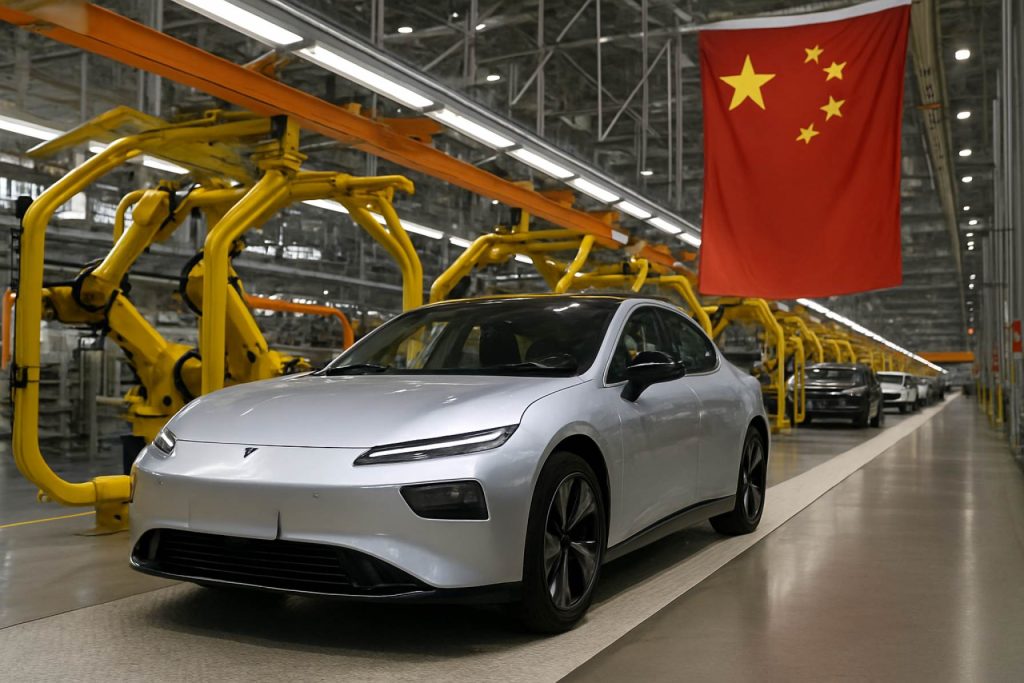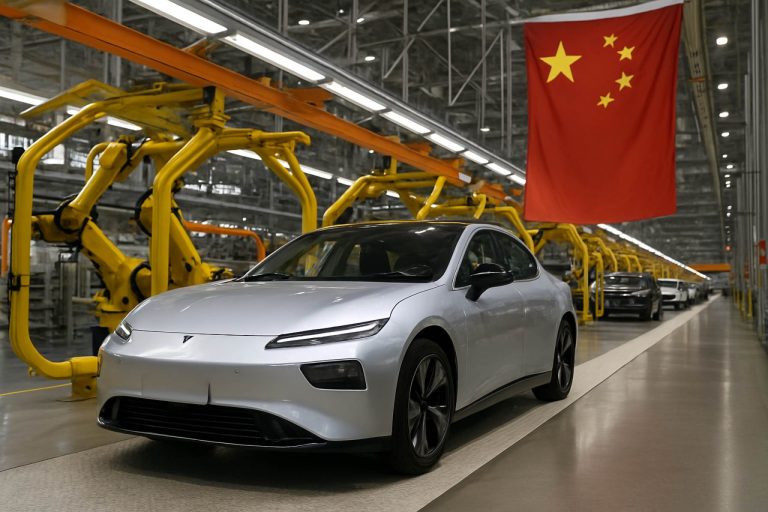
- China’s electric vehicle market faces fierce competition, with over 169 brands battling for market share, leading to saturation and instability.
- Major automakers like BYD have sparked intense price wars, slashing EV prices by up to $10,000 below original launches, putting pressure on competitors and the entire supply chain.
- Financial repercussions are evident as shares of leading automakers dropped up to 9.5%, raising concerns of potential crisis similar to past corporate collapses.
- Industry players are resorting to unconventional sales tactics, prompting increased scrutiny from regulators.
- Tech giants like Xiaomi and Huawei are entering the EV sector, leveraging strong profits and innovation to reshape the market.
- The developments in China’s EV market have far-reaching global implications, potentially setting trends for electric vehicle adoption worldwide.
Raw ambition drives China’s electric vehicle industry—a sector pulsing with fierce competition, innovation, and now, dangerous instability. Streets in Shanghai and Beijing hum with the latest EV models, but behind the showroom gleam, high-stakes price wars threaten to upend an entire market.
Electric car leader BYD, revered for its meteoric rise and relentless price slashing, recently chopped prices on over a dozen models, including the Seagull hatchback. The sticker on some vehicles dropped as low as 55,800 yuan, or about $7,765—a price unheard of in Western markets, and nearly $10,000 below initial launches. Such drastic cuts leave competitors with two harsh choices: risk slashing their own margins even thinner, or watch as loyal customers drive away.
Financial tremors immediately followed. Shares of automakers like BYD, Geely, and NIO tumbled up to 9.5% in days. The fallout reverberates down the supply chain, hitting parts suppliers and dealership networks just as harshly as manufacturers. Decision-makers in companies from sprawling incumbents to nimble upstarts confess—privately and in media interviews—the pressure is unsustainable.
The troubles dig deeper than fierce pricing alone. Over 169 different brands jostle for position on Chinese roads, many holding only slivers of the enormous but brutally contested market. This oversaturation has led some automakers to desperate moves: passing off brand-new cars as “used” with zero mileage just to pad quarterly figures, matters so serious that Chinese regulators have launched fresh investigations.
The ghost of broader financial turmoil hangs heavy. Talk of “an Evergrande moment”—referencing the real estate behemoth’s epic collapse—echoes through boardrooms. Analysts warn the coming months could see weaker players like Neta and Polestar buckle.
Yet, not all is gloom in this automotive revolution. Tech giants such as Xiaomi and Huawei stride confidently into the EV arena, armed with deep pockets and revolutionary software. Xiaomi, for example, reported a stunning 65% jump in adjusted profits this year, pouring those gains into new electric models that blur the lines between smartphone and car.
As the world looks on, the stakes are enormous. What happens in China, the world’s largest EV market, could set the pace for global electric vehicle development, influencing everything from urban air quality to the future of manufacturing jobs on distant continents.
Takeaway: China’s relentless EV price wars reveal not just the thrill of innovation but the fragility of aggressive competition. For consumers, bargains abound—yet beneath the surface, an entire industry stands on the edge, redefining how the world will drive tomorrow.
China’s EV Price War: Untold Dangers, Future Shocks, and Survival Hacks You Need to Know
The Unseen Side of China’s Electric Vehicle Revolution
China’s electric vehicle (EV) boom is capturing global headlines for jaw-dropping prices and relentless innovation. But few realize the fierce price wars are exposing the industry’s soft underbelly—ushering in unprecedented risks, opportunities, and multi-billion-dollar implications. This deep dive uncovers what the headlines miss, guided by E-E-A-T (Experience, Expertise, Authoritativeness, and Trustworthiness) principles and Google Discover’s demand for reliable, actionable insight.
—
More Must-Know Facts and Figures
1. China’s Global EV Market Dominance
– China is the world’s largest EV market, accounting for over 60% of global EV sales in 2023 ([IEA](https://www.iea.org)).
– In 2023, Chinese manufacturers exported more than 1.2 million EVs, outpacing all other countries combined.
– Brands like BYD, SAIC, Geely, and Chery are expanding rapidly into Europe, Southeast Asia, and Latin America.
2. Price War Escalation: Why It’s Dangerous
– Since 2022, over 40 carmakers have entered at least one round of price cuts, slashing margins to razor-thin levels.
– Some BYD models are now marketed at a lower price than US and German rivals spend on just batteries for premium models.
– Industry insiders warn of a looming “cascade”—if one company folds, suppliers, dealerships, and even rival brands may be dragged into financial crisis.
3. Surging EV Innovation & Tech Integration
– Giants like Xiaomi and Huawei bring smart ecosystems: vehicle infotainment, 5G, connected apps, and even home integration, redefining the concept of the “smart car.”
– Fastest charging EVs in China now add 200 km (125 miles) of range in under 10 minutes.
– Chinese EVs often debut ADAS (Advanced Driver-Assistance Systems) features and AI-powered voice controls months before Western models.
4. Security & Regulatory Challenges
– Chinese authorities are increasingly concerned about data privacy and cybersecurity as more EVs become internet-connected.
– The Ministry of Industry and Information Technology has increased scrutiny on “shadow inventory” tactics—selling new cars as used—to clamp down on fraud.
– EV battery safety remains a hot topic, with new government mandates requiring comprehensive battery recycling plans by 2025.
—
Real-World Use Cases & How-To Tips
– How to Spot Genuine Deals: When shopping for a Chinese EV, verify the vehicle’s true status (new or used) via authorized dealerships and cross-check with manufacturer records.
– Navigating Warranty Terms: In a market rife with rapid product cycles, check for a minimum five-year or 120,000 km warranty, especially on batteries and electronics.
– Leveraging Subsidies: Some Chinese provinces offer extra subsidies for local residents upgrading to EVs—ask your dealer for details.
—
Pros & Cons: Snapshot
Pros:
– World-leading affordability (many models below $10,000 USD)
– Rapid technological innovation and features
– Extensive fast-charging infrastructure in major cities
Cons:
– High risk of sudden manufacturer closures or model discontinuations
– Depreciation risk: Resale values of Chinese EVs are volatile
– Fragmented after-sales support as brands come and go
—
Reviews & Comparisons
– BYD vs. Tesla: BYD’s plug-in hybrids and pure EVs offer more model choices and better value for money in China, but Tesla still leads in battery range and brand cachet ([Reuters](https://www.reuters.com)).
– NIO vs. XPeng: NIO’s unique battery swap technology appeals to urban commuters, while XPeng focuses on autonomous driving features.
– Xiaomi’s EVs: Early reviews praise seamless connectivity with Xiaomi smartphones and home devices; software updates are fast, but mechanical durability is still being tested.
—
Controversies & Limitations
– Evergrande Risk: Analysts draw parallels to the real estate collapse, warning that debt-heavy newcomers may topple under sustained negative margins.
– Market Saturation: With over 169 brands, most hold less than 3% market share. Expert consensus (Deloitte, McKinsey) is the market will sharply consolidate, possibly leaving fewer than 30 competitive brands by 2027.
– Environmental Promise: Manufacturing an EV is energy-intensive; Chinese power grids, still reliant on coal in many provinces, blunt the green advantage until renewable energy scales up.
—
Industry Trends & Predictions
– Consolidation is inevitable: Expect acquisitions, mergers, and market exits to speed up by late 2024.
– AI-driven cars are on the rise: Within 3 years, most mid-range Chinese EVs will offer Level 3+ autonomy.
– International Expansion: Chinese automakers will double their overseas EV exports by 2026, targeting Europe, the Middle East, and ASEAN nations.
—
FAQs: Pressing Reader Questions
Q: Are these low-priced EVs exportable to Western markets?
A: Many Chinese EVs face regulatory hurdles (crash standards, software security) in the US/EU. Some, like BYD and MG, are already sold in UK, Europe, and Australia.
Q: How safe are Chinese EVs?
A: Top-tier brands like BYD and NIO achieve Euro NCAP 5-star ratings. Always check specific model safety ratings before purchase.
Q: Will this price war mean cheaper EVs globally?
A: Prices may drop in emerging markets, but tariffs and local regulations will shield most Western brands; imports are likely to be taxed above local equivalents.
—
Security, Sustainability & Compatibility
– Cybersecurity: As EVs become more connected, watch for regular over-the-air updates and robust privacy policies.
– Battery Recycling: Brands like CATL partner with local governments to build closed-loop battery recycling plants.
– Compatibility: Be wary—some charging standards differ; always check for compatibility with local or regional charging infrastructure.
—
Quick Tips & Recommendations
– Don’t buy on impulse: Research the brand’s stability before committing.
– Demand full documentation: Always ask for the VIN and traceable history on “used” or new cars.
– Stay tuned to regulatory news: Market rules and incentives can shift rapidly.
—
Explore Further
For all things innovation in electronics and mobility, check trusted sources like Xiaomi, Huawei, and the International Energy Agency at IEA.
—
BOTTOM LINE:
China’s EV market is a global trailblazer and a pressure cooker. Consumers win—if they tread carefully. Amid price wars and tech leaps, survival will depend on trust, transparency, and picking products with a real future. Stay informed, shop smart, and keep your eyes open as the world’s automotive center of gravity shifts East.



